Rabbit’s foot fern care is easier than you might think. In this complete guide, I’m going to tell you everything you need to know. I’ll give you tons of tips that will help make you successful growing rabbit’s foot fern either indoors or outside.
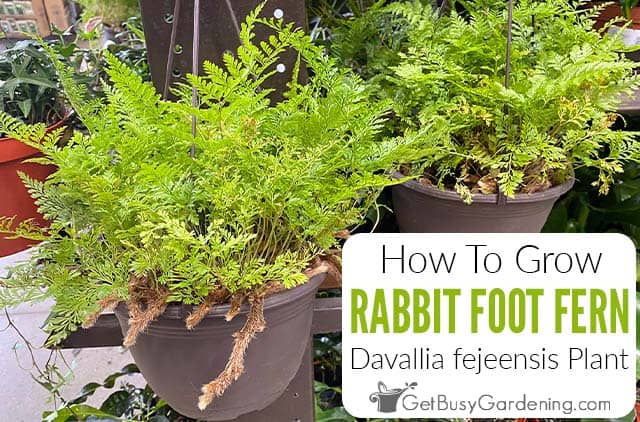
With its delicate, gauzy leaflets and furry brown feet that give this houseplant its common name, rabbit’s foot fern is a popular choice for hanging baskets and shallow pots.
These easy to care for plants are fun to keep indoors, once you understand their specific growth habits.
Even newbies can learn how to take care of a rabbit’s foot fern with everything I’ve included in this guide.
Read on to learn what makes them unique, and get detailed growing instructions for water, light, fertilizer, propagation, and much more.
What Is A Rabbit’s Foot Fern?
Rabbit’s foot fern (Davallia fejeensis, aka Lacy Paw or Fijian Hares’ Foot Fern), is native to Fiji.
It’s an epiphyte, like bromeliads and orchids, which means it takes nutrients from the air, rainwater, or forest debris through the fronds and rhizomes.
Out in nature, we’d find it growing on rocks or trees, rather than rooted into the ground.
But they drape beautifully over the edge of containers as well. This makes Davallia fejeensis a popular plant for hanging baskets.
The fuzzy rhizomes come in an array of shades from gray, to yellow, and brown, and resemble rabbit’s feet, hence the common name.
The beautiful top growth can get up to 2’ tall and features long, lacy fronds of delicate green leaflets that give it a bushy, soft appearance.
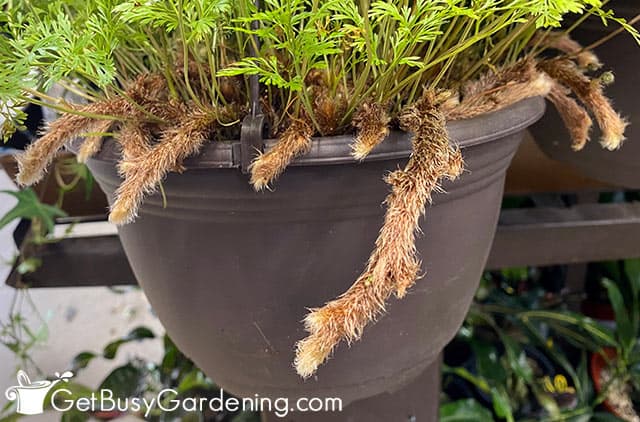
How To Grow Davallia fejeensis
Before we get into how to care for a rabbit’s foot fern, let’s talk about the best places to grow one. That way you’ll have all the details you need to pick the perfect spot.
Hardiness
Davallia fejeensis is a perennial fern that is hardy in zones 10 and 11. For everyone else, they’re best kept indoors, or wintered inside when temperatures drop below 55°F.
Though they don’t tolerate frost or direct sun, they’re tough plants that recover well from poor conditions. That makes them perfect for beginners!
Where To Grow Rabbit’s Foot Fern
If you live in a warm enough location, you can grow your rabbit’s foot fern outside all year long.
Keep it protected from direct sun, preferably in a full shade location. Since they’re epiphytes, you can put yours in a decorative container, or mount it on a rock or tree.
Indoors, they prefer bright, indirect light, and require consistent humidity. If you want, you can move it to a shady spot in your garden when nighttime temperatures remain above 55°F.
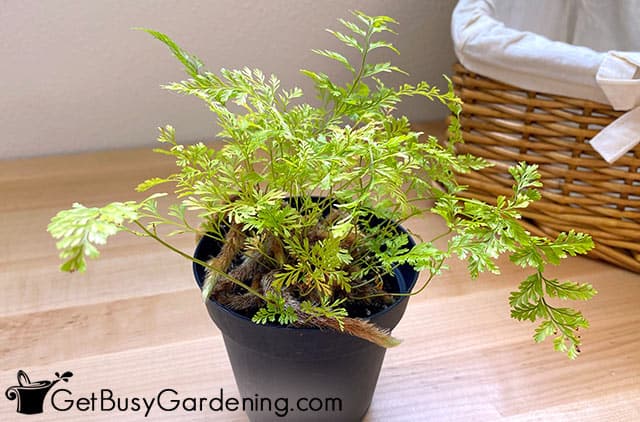
Rabbit’s Foot Fern Care Instructions
Now that you have the perfect spot picked out, it’s time to learn how to care for your Davallia fejeensis so it can thrive for decades to come.
Light
Rabbit’s foot ferns are shade loving and thrive in indirect light. This makes them ideal houseplants. They’ll grow happily in a bright room, no south facing windows required.
When outside, keep them in full shade. Direct sunlight can scorch the delicate leaflets and dry out the rhizomes.
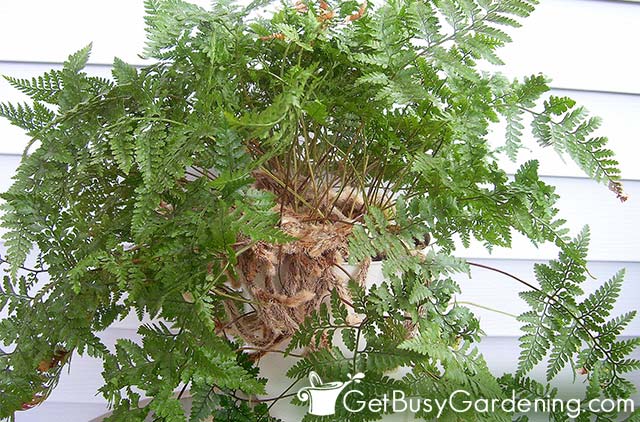
Water
As epiphytes, rabbit’s foot ferns can take in water from the air, rain, or through the surfaces they sit on.
Indoors keep the soil moist, but never soggy. Since rainwater is a natural source for them, they’ll like an overhead watering indoors too.
When they’re mounted, watering is more hands-on. Provide moisture through daily misting, ensuring the feet and fronds don’t dry out.
I recommend using distilled water or rainwater if possible. Davallia fejeensis can be sensitive to the salts and chemicals found in tap water.
Humidity
Since the are epiphytes and get their moisture in from the air rather than the soil, Davallia fejeensis need lots of humidity.
If you live in a dry climate, mist your rabbit’s foot fern daily, especially if you’re growing it on a board or rock.
To cut down on how often you need to give it a spritz, running a humidifier nearby, and keeping your fern in a humid location like the bathroom can help. A humidity monitor will help ensure they are getter enough.

Temperature
Though they’re resilient, extreme heat or cold can be damaging or even fatal. Their ideal temperature is between 60-75°F.
When temperatures drop below 55°F, the plant can experience the loss of fronds, called leaf drop, which can ultimate kill them.
If temperatures reach above 75°F, they may require frequent watering and misting to prevent them from drying out. So make sure to keep a thermometer nearby so you can monitor temperature changes.
Fertilizer
Most plants need the occasional fertilizer, and these are no exception. During the spring and summer you can fertilize your rabbit’s foot fern every 2-3 weeks through foliar feedings.
Always use a diluted organic liquid fertilizer, compost tea or fish emulsion, as they can be sensitive to synthetic chemicals.
Soil
Despite not needing to be in a pot, rabbit’s foot ferns can be particular about the type of potting soil they sit in. If you choose to keep yours in soil, they’ll need a neutral pH.
The rhizomes cannot tolerate sitting in soggy soil for long. So choose a well draining, but moisture retaining commercial mix. Or you could use pine bark or an orchid medium instead.
If you’d rather skip the soil, try mounting yours on a board or log using sphagnum or peat moss.
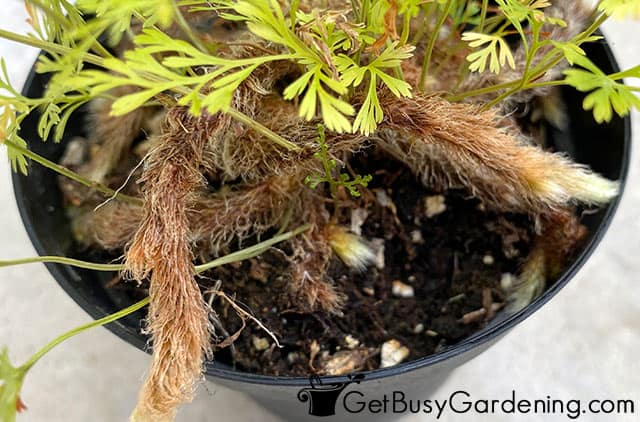
Repotting
Repotting is not a requirement for rabbit’s foot fern. They love to be pot-bound, and you will too when the furry feet begin to crawl over the sides of the container.
But extremely pot-bound plants can experience slow growth. A new home with more room and fresh soil can reinvigorate it.
The best time to repot them is in the spring. Choose a container that’s no more than 1-2” larger than the previous one. Be sure to never bury the rhizomes to prevent rotting.
Pruning
Good news, your Davallia fejeensis doesn’t require any special pruning. If there’s browning or yellowing on the leaflets however, you can snip or pinch those off easily.
Use a clean pair of micro-tip pruners and trim just below the discolored or dying fronds. This will keep it looking healthy and encourage bushier growth.
How To Deal With Common Pests & Disease
Rabbit’s foot ferns are unfortunately susceptible to all the typical houseplant pests including spider mites, white flies, mealybugs, scale, aphids, or fungus gnats.
The best option is to manually remove the affected fronds and obvious bugs. You can also try a cotton swab dipped in rubbing alcohol to kill and remove them.
For more serious infestations, neem oil or insecticidal soap solutions can be helpful in small, diluted doses.
Test them first and use sparingly to manage the pests, they don’t like to be coated too often.
Rabbit’s Foot Fern Propagation Tips
Once you’ve fallen in love with your rabbit’s foot fern, you’ll be delighted to know it’s very easy to propagate by cuttings or division.
With a clean pair of sharp pruners take a 3-4″ cutting of a rhizome that has at least one frond attached to it.
Dust it with rooting hormone, set it on top of moist soil, and pin or tack it down. Mist it daily until you see new growth.
To divide it, remove it from the pot, and carefully separate the rhizomes. Then pot up the new division into a container, or try mounting it.
Troubleshooting Common Problems
Rabbit’s foot ferns are resilient and can often recover if problems are quickly addressed. Get my tips on resolving the most common ones below.
Rabbit Foot’s Fern Turning Brown
When rabbit’s foot fern fronds starts turning brown, it usually indicates a lack of humidity. This problem can be solved simply by increased mistings or running a humidifier nearby.
However browning at the rhizomes may be caused by root rot, usually a symptom of sitting in water for prolonged periods. If that’s the case, ensure you’re not overwatering, and that soil is well draining.
Fronds Yellowing & Tips Brown
Yellowing fronds and brown tips on a rabbit’s foot fern are often caused by either direct sunlight or too little moisture.
Increase the humidity level around the plant, and double check that the soil stays consistently moist. Also, check the amount of direct sunlight it’s getting, and protect it from intense sun and heat.
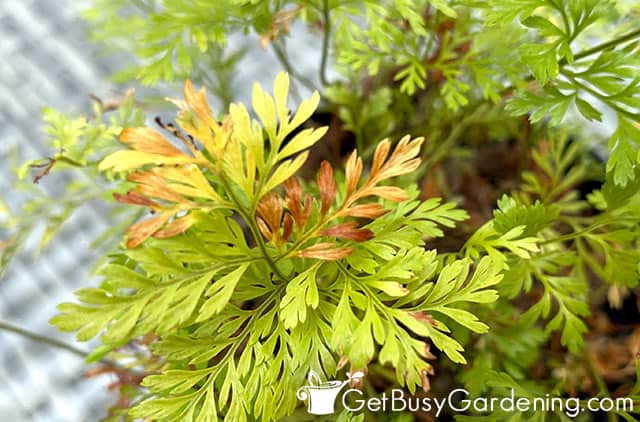
Pale Fronds & Plant Lacking Growth
Pale fronds and stunted growth usually means too much light or lack of nutrients for Davallia fejeensis.
Move it to a lower light area to see if that corrects the problem. If it’s still experiencing slow growth, a dose of organic fertilizer may help invigorate it.
Limp Fronds
Limp fronds are most commonly caused by overwatering. Keep the soil damp, but not wet, and make sure the rhizomes never sit in water.
If you struggle with keeping your plants watered properly, an inexpensive moisture gauge can help you get it right.
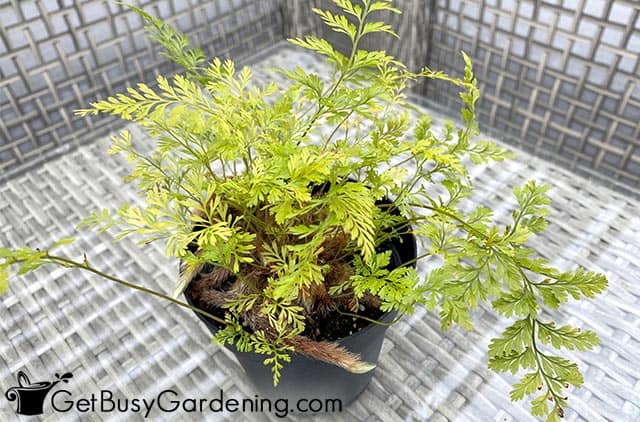
FAQs
We’ve covered a lot of information about rabbit’s foot fern care, but you may still have a question or two. I’ve answered the most frequently asked ones below.
Are rabbit foot ferns toxic?
No, rabbit’s foot ferns are not toxic. According to the ASPCA website they are safe to have near your dogs and cats.
What pot size is best for rabbit’s foot fern growth?
The best pot size for rabbit’s foot fern growth is a shallow container that’s one to two inches larger than its current one.
Why is my rabbit’s foot fern dying?
There are many reasons why your rabbit’s foot fern is dying. The number one cause is overwatering, which can lead to rotting of the rhizomes. But exposure to temperature extremes (too hot or too cold), lack of humidity, or too much direct sun could also be causes.
Rabbit’s foot ferns are easy to care for, and make excellent houseplants. Thanks to those fuzzy brown feet, they’ll grow in a wide variety of containers, and look good while they do.
If you want to learn all there is to know about maintaining healthy indoor plants, then you need my Houseplant Care eBook. It will show you everything you need to know about how to keep every plant in your home thriving. Download your copy now!
More About Different Types Of Houseplants
- How To Care For Staghorn Fern (Platycerium bifurcatum)
- How To Care For An Orchid Cactus Plant (Epiphyllum)
- African Milk Tree: How To Grow & Care For A Euphorbia trigona Plant
- Wandering Jew Plant Care & Growing Guide
Share your tips for growing and caring for rabbit’s foot ferns in the comments section below.
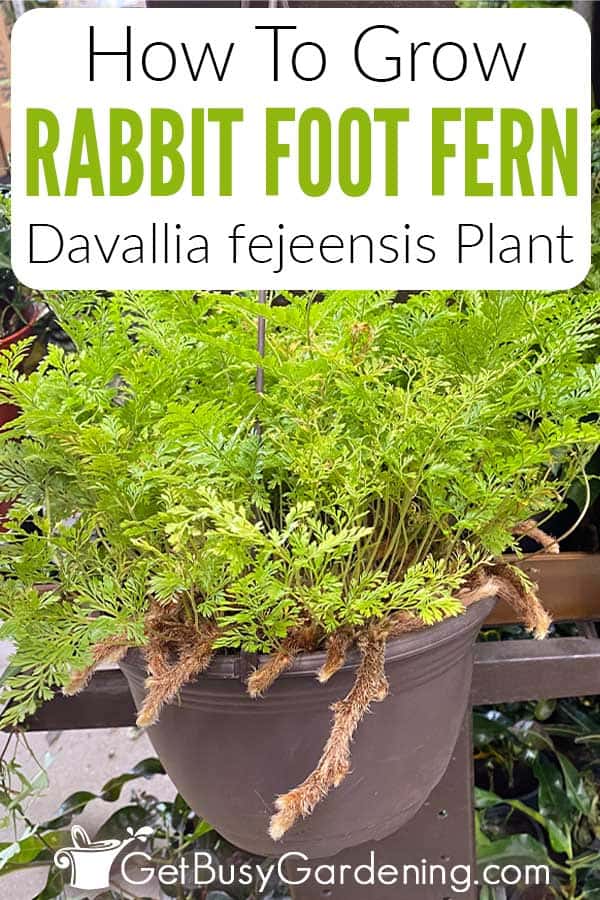





Carol Richards says
My niece gave me a rabbit’s foot fern for my birthday in July. It’s beautiful and is doing well, but doesn’t seem to have feet. I’ve had rabbit’s feet ferns before, and once the feet were buried, but I lifted the soil a little bit and found them. I can’t find the feet in this fern. I did take a picture of it in case there was another similar looking fern. Rabbit’s foot fern is how it was identified in my plant app. Do you have any ideas or suggestions? Thank you.
Amy Andrychowicz says
There are a few reasons why rabbit’s foot ferns may not form the furry rhizomes we commonly call their “feet”. The most common reasons are too much or not enough water, lack of light, or if it’s too cold. But it can also take some time for the plant to become mature enough to form the fuzzy rhizomes. They also like to be pot-bound, so it may be that the plant was recently repotted before you got it, which means it could take some time for it to become established.
Marian Warren says
Thanks for your helpful comments. Meant to say the fern is ,,,maybe a 100 years old…my father started it when we lived in San Diego. I live in Washngton now and it was doing well for 10+ years. As i wrote, i am trytug to pot a couple of feet I have started. As I wrote, I want to put it in a hangng basket
Amy Andrychowicz says
If it’s doing well in the current pot, there’s no need to repot it. But you certainly could hang the pot it’s in, rabbit foot ferns do very well in hanging baskets. However, if it has outgrown the current pot, then yes, put it into a slightly larger hanging basket. I would personally plant the new babies in their own pot, but you can put them into the same pot as the mother as long as there’s room.
Marian Warren says
Can I pot my rabbit fern in a hanging basket?
Amy Andrychowicz says
Yes, rabbit’s foot ferns do very well and can look fantastic in a hanging basket!
Vicki Long says
Hi, I have a very large 100lb + rabbits foot fern given to me 30 years ago. It is in a basket. The tree we had it on is damaged from the weight so we have it sitting on a wine barrel now but it’s not doing well. Any suggestions on how to hang it on a post that will hold the weight?
Amy Andrychowicz says
I would move the rabbit’s foot fern so it’s positioned under the tree where it used to be hanging, since it obviously loves that spot. You could either put it on the ground, get some kind of pedestal to set it on, or build a strong post to hang it (like you suggested). Any of those options would be great.
Lucy Baker says
I need to repot my rabbits foot fern. We had a hard winter (zone 10) with much rain. Half of the rhizomes are black, but not dead. It is currently in a clay pot and I had to cut it off of a wire shelf. It is about 15 – 20 years old. I want to hang it. What is the best pot to consider? Your pictures show plastic but that seems so temporary as they break in just a few years.
Amy Andrychowicz says
If you’ve had success using a clay pot for growing your rabbit’s foot fern, then you can stick with that. I personally use plastic because they are lighterweight for hanging. As long as you buy a quality one, the plastic should definitely last for more than a few years.
Lady T says
My rabbit foot fern was doing so well, so pretty and happy in the hall. No direct sun, watered it once a week. No sudden change in temperture.Then it started to wilt, I fed it an organic fertalizer. It was fine for weeks but then started to droop, it’s been in a really sorry state for weeks now. I watered it, though maybe I over watered it so let it dry out. Still dying! Most of the leaves are dead and falling off, but some are still ok. It’s in it’s original pot, pourous hanging basket. It’s sitting in it’s pot damp. Do you think i over fertilised it? I put quiet a bit on the in then took it out as I thought it was the fertiliser. My ferns do so well for months and months, then they I kill them 🙁
Amy Andrychowicz says
Oh no, sorry to hear your rabbit’s foot fern is struggling! It does sound to me like it’s been overwatered, and unfortunately may be suffering from root rot. They like to be evenly moist, but dry out slightly between waterings. The best you can do is keep the soil on the dry-ish side, though never bone dry, stop fertilizing, and wait for it to recover. Good luck!
Jeanett says
My rabbits foot fern dropped all fronds many months ago. They never grew back. It get misted daily, bright light, roots ok, not too much water
So how can I stimulate it to re-grow the fronds. It was a small plant when new. I live in northern NJ with NE window (no choice as I live in an assisted living facility with 30 plants). This is my favorite.
Love reading your plant advice
Amy Andrychowicz says
Oh no, I’m sorry to hear that your rabbit foot fern is not doing well. Unfortunately, if it lost all of the fronds many months ago, and nothing has grown back yet, I think your plant is likely dead rather than dormant. 🙁 However, you mention that the roots are ok, do you mean the furry “feet”? If so, then there might be hope for it, and it might just be too cold. If the furry feet are plump and healthy, then I would try to give it more warmth (move it away from the freezing cold window), and then begin giving it a weak dose of fertilizer in the spring to see if it will start growing new fronds again. Good luck!
Rebecca says
I have a really large round hanging fern. It is beautiful during the summer when outside under the porch. When it starts getting below 55 I put it in my bathtub hanging off a small ladder so that it continues to hang. The window is a group of glass squares that face the west. My problem is that the leaves are turning brown and dying. Is it too dry, or not enough light? I have ordered a grow light, how long should I set it for and what intensity? It is so large and beautiful I want it to survive, please help.
Thanks, Rebecca
Amy Andrychowicz says
When the leaves on rabbit foot ferns turn brown, it’s almost always a lack of moisture. So yes, if the soil is moist, then it’s most likely caused by lack of humidity. You can try misting it or running a humidifier nearby.
Suzanne says
I have had my rabbit foot fern for 42 years! It started as a 4″ pot and seems to have thrived on neglect in both indoor and outdoor locations over the years. Finally, though, it seems to be ready to five up the ghost. Thanks for this helpful info. Maybe I can save dear “Flopsy” for a few more years.
Amy Andrychowicz says
WOW, 42 years?? That’s amazing! You’re welcome, I sure hope you can save your beloved rabbit’s foot fern “Flopsy”, I’m cheering for you both! 🙂
catriona dowling says
brilliant articles. thank you.
Amy Andrychowicz says
Thank you, and you’re welcome!
Dee Lucas says
This article is very interesting and I really enjoyed and learned from it. I found it particularly interesting that they should be grown in shade. I live in Zone 9b and have a rabbit foot fern and an azalea growing in a pot together, sitting on the ground. They get sun for most of the day and both are doing great. They have been in this position for several years. Hopefully my luck dosen’t run out or maybe I’ll just move them. Thanks for all your great articles. I’m obsessed with plants, inside and out.
Amy Andrychowicz says
If your rabbit’s foot fern is happy in its current location, there’s no need to move it. It might be getting some dappled shade from the other plant, or maybe there’s a nearby structure or trees that protect it. The fronds can definitely burn out in the afternoon sun, especially in the hot summer months when it’s most intense. But yours seems to be happy where it is, so I would just leave it be. 🙂
Dee Lucas says
I also live in Zone 9B and have a rabbit’s fern and azalea growing in a pot and it gets full sun all day and have been for years.
Teresa says
I have a rabbits foot fern that is probably 10 years old. I love it, but, do I need to cut the feet that grow over the top of the pot?
Amy Andrychowicz says
Nope, no need to cut off the rabbits feet on your fern unless they die. Leaving them growing over the pot is part of the charm of this cool plant. 🙂
Jennifer says
Can you stop root rot in rabbit’s foot ferns after it has started? If so how?
Amy Andrychowicz says
Root rot in rabbit’s foot ferns is very common when they are planted in soil. They are epiphytes that attach themselves to trees in nature, and get many of their nutrients from the air rather than the soil. So, it is possible to stop the root rot as long as you allow the soil to dry out more between waterings, and give them lots of humidity. See the “water” and “humidity” sections above for all the details. Good luck!